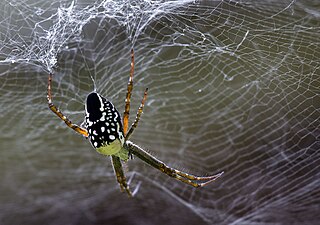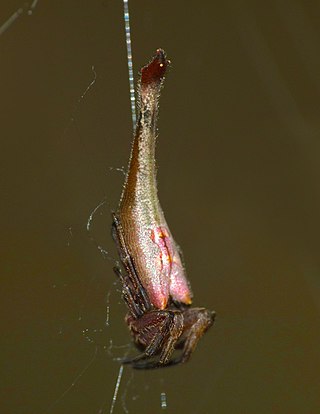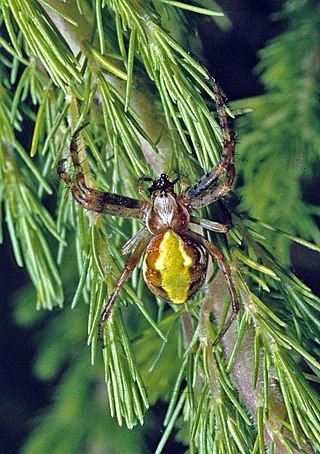
Orb-weaver spiders are members of the spider family Araneidae. They are the most common group of builders of spiral wheel-shaped webs often found in gardens, fields, and forests. The English word "orb" can mean "circular", hence the English name of the group. Araneids have eight similar eyes, hairy or spiny legs, and no stridulating organs.

Argiope protensa, commonly known as the tailed grass spider or teardrop spider, is a species of spider in the orb weaver family, Araneidae. This species is fairly common and widespread in Australasia, but like many spider species, little is known of its ecology, biology, or life history.

The Artoriinae are a subfamily of wolf spiders. The monophyly of the subfamily has been confirmed in a molecular phylogenetic study, although the relationships among the subfamilies was shown to be less certain.

Cyrtophorinae is a subfamily of spiders in the orb-weaver spider family. Unlike other orb-weavers, spiders belonging to Cyrtophorinae build horizontal, finely meshed platforms within a tangle of irregular webs. The usually dome-shaped platform is a non-sticky orb web.

Socca pustulosa known as the Knobbled Orbweaver is a Orb-weaver spider species in the family Araneidae, and it was first described by a French scientist Charles Athanase Walckenaer in 1841 from Tasmania, Australia, but later on when Walckenaer examined the specimen collected from New Zealand and renamed it as a different species- Epeira verrucosa. Until 1917, Dalmas reviewed the Australian pustulosa and New Zealand verrucosa and realized they were the same species. Although S. pustulosa has been accepted for some time in the genus of Eriophora, the evidence supporting its placement within this genus were not fully convincing. Therefore, an alternative view was proposed in 2022- a new genus established to accommodate pustulosa along with 11 other spider species from Australia; the diagnostic test based on haplotype analysis and systematic morphology study by arachnologists and found the anatomical features of male pedipalp terminal apophysis differs from other orb-web species.

Backobourkia is a genus of South Pacific orb-weaver spiders first described by Volker Framenau, Nadine Dupérré, Todd Blackledge & Cor Vink in 2010. It is a common Australian spider, closely related to Eriophora and placed in the "coxal hook clade" of the Araneinae subfamily of Araneidae. Females are generally the same size among all species, but males are much smaller, suggesting male dwarfism throughout the genus. The genus name is a play on the well-known Australian idiom, "Back of Bourke", meaning very remote and beyond the limits of civilization.
Cyrtobill is a genus of Australian orb-weaver spiders containing the single species, Cyrtobill darwini. It was first described by V. W. Framenau & N. Scharff in 2009, and has only been found in Australia.

Demadiana is a genus of Australian araneomorph spiders in the family Arkyidae, first described by Embrik Strand in 1929.
Exechocentrus is a genus of Madagascan orb-weaver spiders first described by Eugène Simon in 1889. It is a bolas-using spider, capturing its prey with one or more sticky drops at the end of a single line of silk rather than in a web.

Acroaspis decorosa is a species of orbweaver spider that is endemic to New Zealand.

Novakiella trituberculosa is a species of South Pacific orb-weaver spiders, found in Australia and New Zealand.

Cyrtarachninae is a subfamily of spiders in the family Araneidae. The group has been circumscribed in several different ways. It originated as the group Cyrtarachneae, described by Eugène Simon in 1892. The group was later treated at different ranks: as a tribe, both under Simon's name and as Cyrtarachnini, and as the subfamily Cyrtarachninae. Circumscriptions have varied. The broadest circumscription, Cyrtarachninae sensu lato (s.l.), includes three of Simon's original groups, including the bolas spiders. Unlike most araneids, members of the subfamily do not construct orb webs, some not using webs at all to capture prey, some using one or more sticky drops on a single line, while others construct webs with few widely spaced non-spiral threads, some triangular. Many have been shown to attract prey by producing analogues of insect sex pheromones, particularly to attract male moths. Adult females may mimic snails, bird droppings and other objects, and so are able to remain exposed during the day time, capturing prey at night.

Cyrtarachne inaequalis is a species of spider in the orb-weaver spider family Araneidae, found in India, Myanmar, China and Korea. Spiders in the genus Cyrtarachne construct "spanning-thread webs" rather than the more typical orb webs of the family Araneidae. These webs have a small number of radii and instead of a tight spiral of sticky threads, the sticky spanning threads are widely spaced and do not form a spiral. When prey is caught on one of the spanning threads, one end comes loose, and the prey, often a moth, dangles from the other end until hauled in by the spider.

Backobourkia brouni,, or Broun's marbled orb-weaver, also often referred to by its synonym Backobourkia brounii, is a spider native to Australia and New Zealand.

Arachnura feredayi, the tailed forest spider, scorpion spider or drag-tailed spider, is endemic to New Zealand. It is known for the distinctive tapering body shape in females, which are also much larger than males, and for producing vertical columns of egg sacs in their webs.
Volker W. Framenau is a German-born Australian arachnologist and entomologist.

Hortophora is a genus of South Pacific orb-weaver spiders first described by V. W. Framenau, R. L. C. Baptista and F. S. M. Oliveira in 2021.

Salsa fuliginata, commonly known as the sooty orbweaver, is a orb-weaver spider of Araneidae in the genus Salsa. The species is found throughout southeastern Australia and New Zealand.
Abba transversa is a species of orb-weaver spider, found in Queensland and New South Wales, Australia. It is the only species in the genus Abba.

Novaranea queribunda is a species of Araneidae spider that is endemic to New Zealand.
















